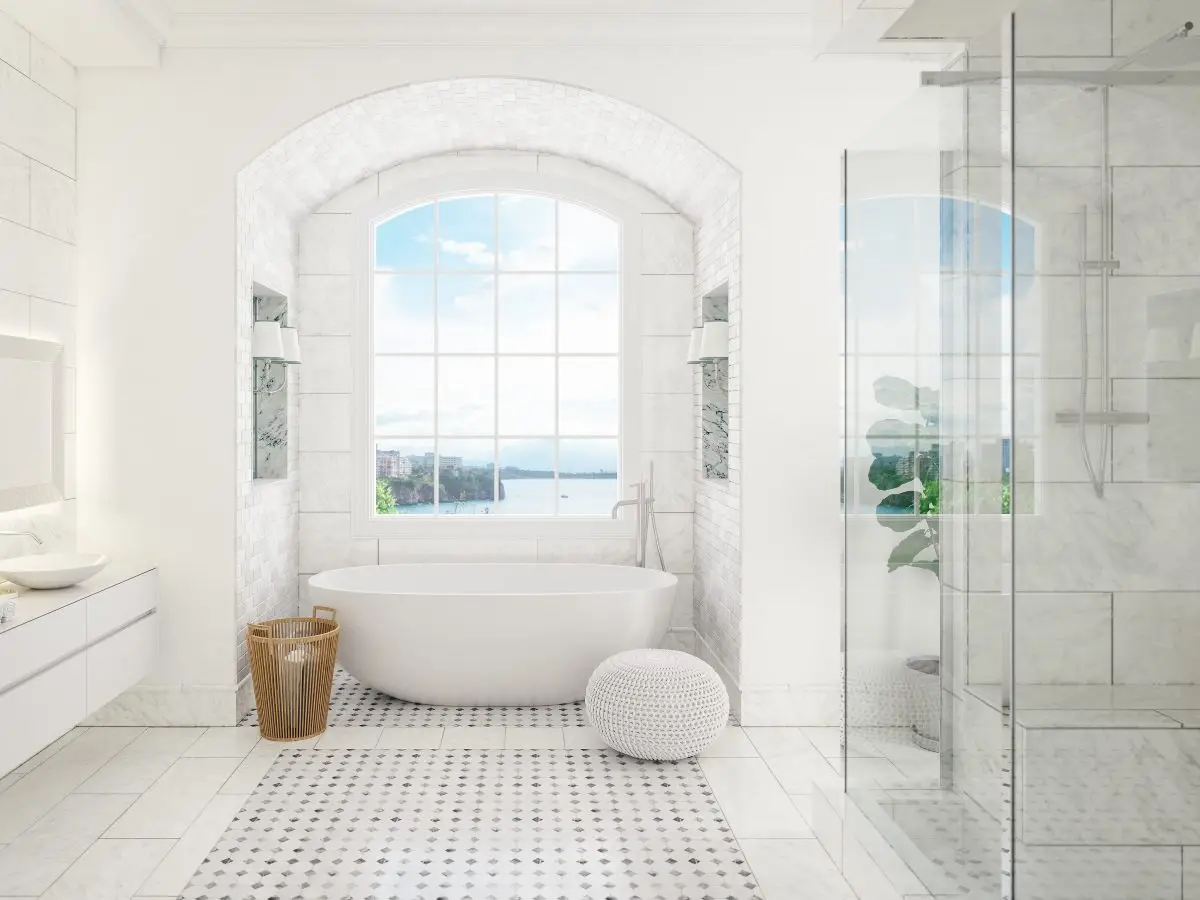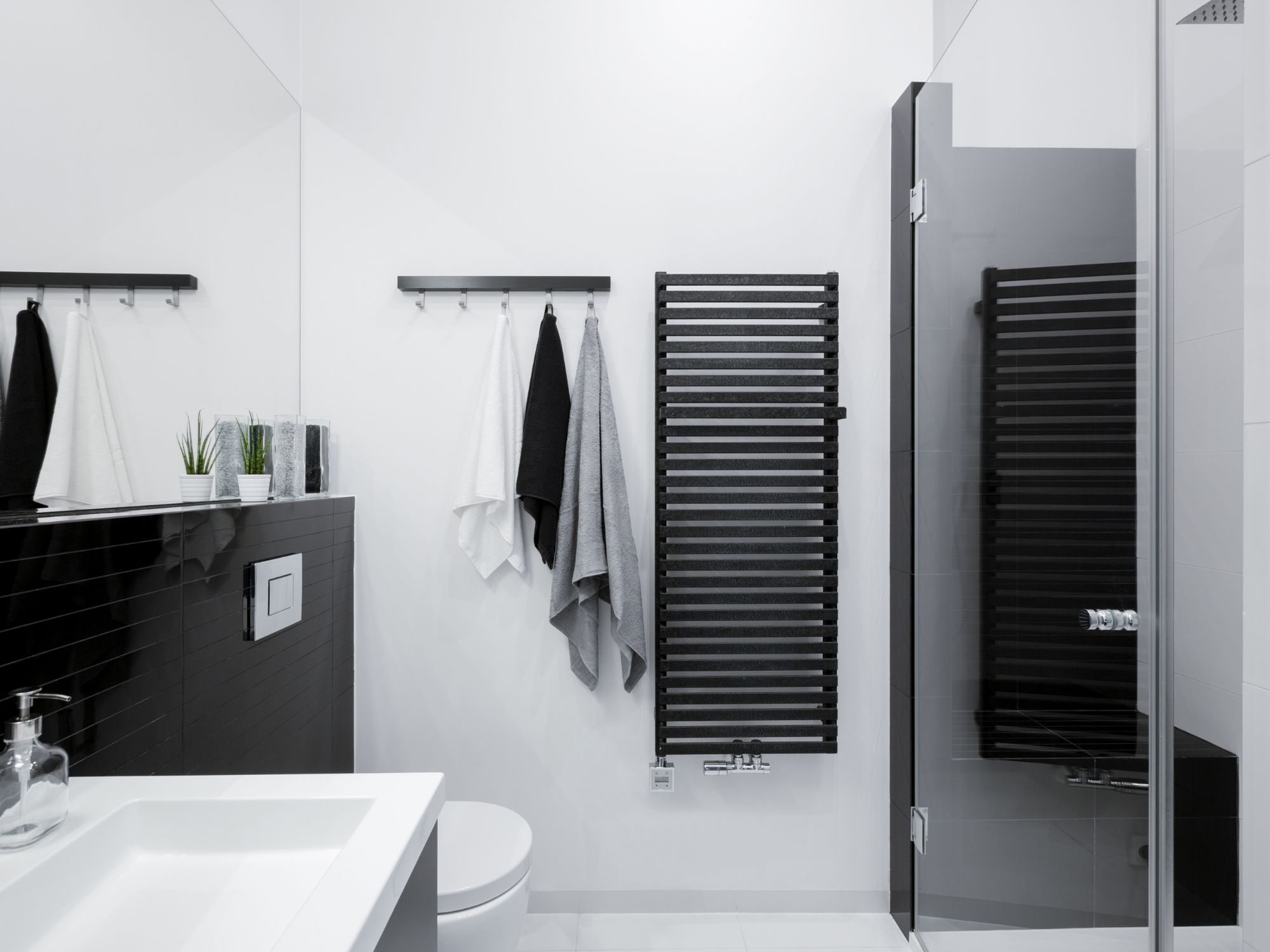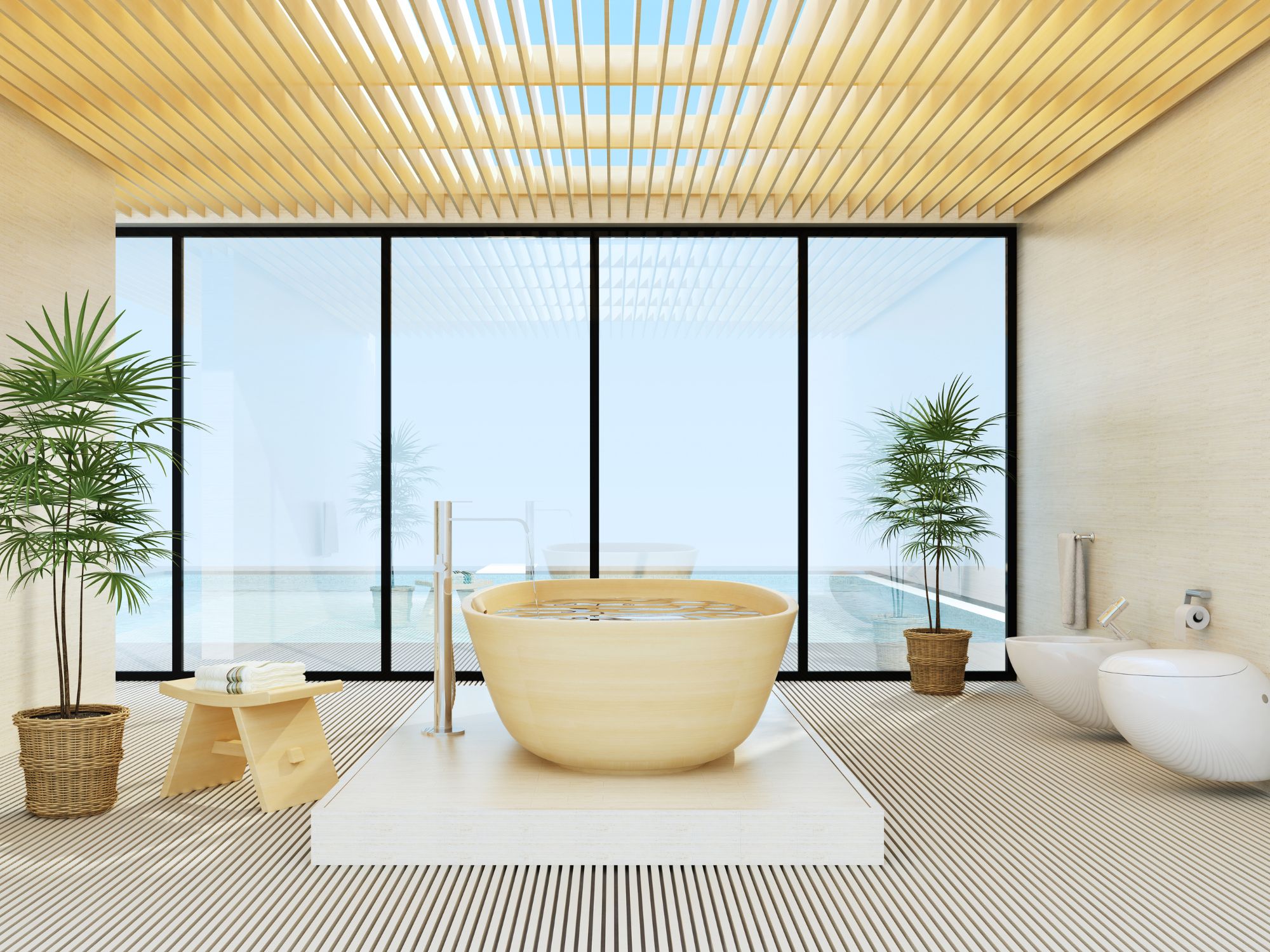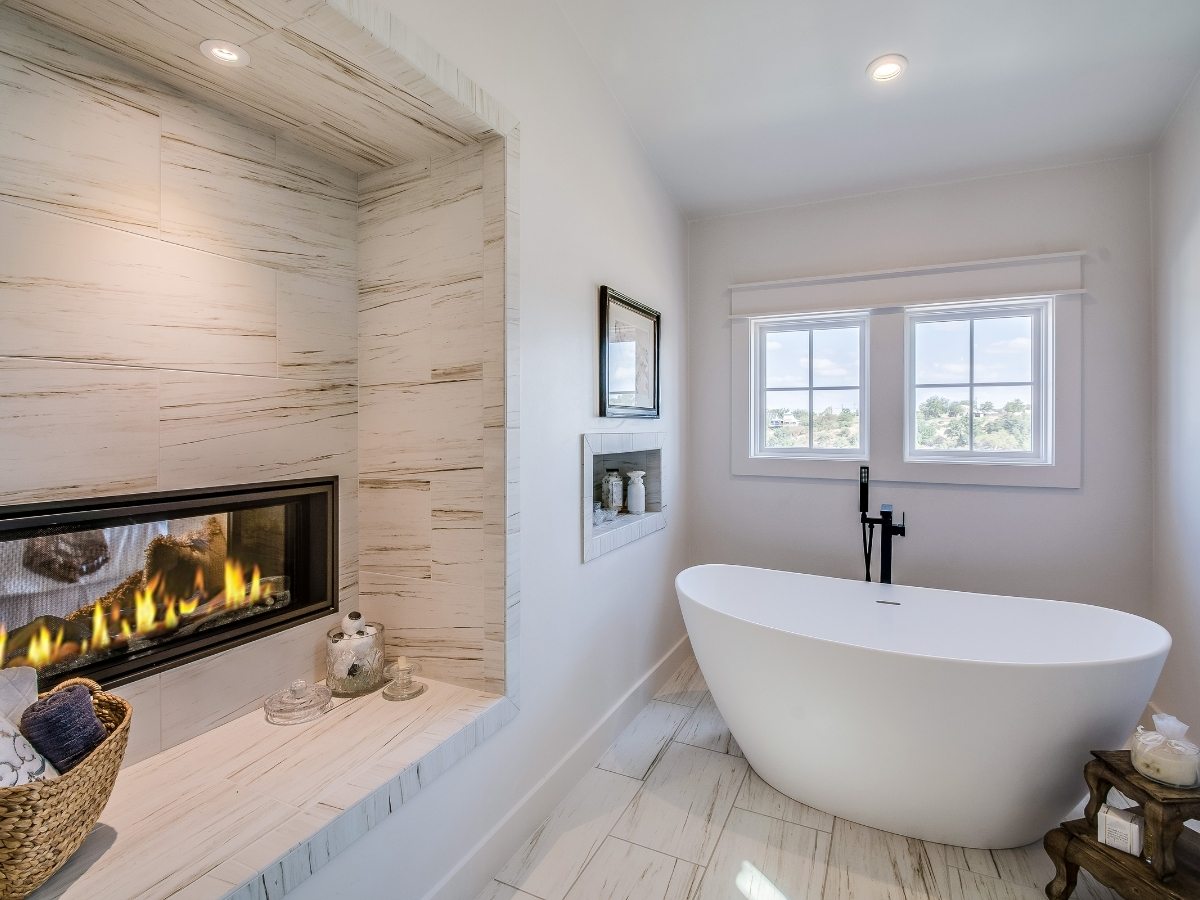This post may contain affiliate links which means I may receive a commission for purchases made through links. I only recommend thermostatic shower systems products that I have personally used or curated specifically after reviewing and ensuring its quality! Learn more on my Private Policy page.
1. Thermostatic Shower Controls
Components of a Thermostatic Shower Controls System:
Standard Shower Systems
Standard showers are the basic, typical showers many grew up with a single showerhead and a turn knob to regulate temperature. In contrast, modern systems have many more components including, shower heads, handhelds, jets, sprays, rain heads, and thermostatic shower controls.
In other blog articles we explored, shower systems, shower panels, and shower steamers which are all critical to setting up a spa like environment to enhance your shower experience.
Shower Systems with Body Jets
These systems have multiple jets placed at various heights, ensuring a full-body spray. Body jet sprays are strategically positioned nozzles that offer a targeted body sprays streams. They can be runed on or off with push button and flow rate controlled with levers.
They can be adjusted to hit specific areas of the body, such as the back, shoulders, or legs. Unlike traditional showerheads, they are designed to deliver body sprays horizontally or at a slight angle.
The main allure of body jet sprays lies in their spa-like experience. They can soothe sore muscles and offer a massage-like feel. The sensation of multiple jets working simultaneously provides a comprehensive luxurious experience.
Jets require apt water pressure and might be a bit heavy on the water bill. Usually placed at multiple levels on the shower wall, their position can be adjusted based on the user’s height and preference.
Rain Shower System
Known for their wide head and gentle flow, they replicate the feeling of standing in soft rainfall and are designed to mimic the gentle, soaking nature of natural rain. These showerheads are typically broader and flatter than standard showerheads and are positioned directly overhead to provide a downward water flow.
Raindrops is universally loved. Rain showers provide an immersive, gentle, and even water flow, evoking a sense of tranquility and relaxation. They often become the focal point of luxury bathrooms, combining aesthetics with a serene showering experience.
While ceiling-mounted gives a direct overhead flow, wall-mounted versions can be adjusted to different angles. The design can be traditional round or modern square, fitting different bathroom aesthetics. Ceiling mounts provide a very luxury expression and typically can accommodate larger rain heads
Handheld Shower System
A hand shower is detachable showerheads connected to a hose, offering flexibility in directing the water flow to the desired locations. The hand shower can be used in tandem with a fixed showerhead or independently.
The adaptability of hand showers is what makes them popular. They’re ideal for tasks like rinsing off shampoo, cleaning the shower enclosure, or aiding in personal hygiene. For households with children or pets, a handheld shower can simplify bath time.
Additionally, they can be easily adjusted for height, making them accommodating for users of all ages.
The hand shower can be wall-mounted or fitted to a sliding bar, and hose length varies, typically between 60 to 80 inches. Whether the slide bar included or not depend on the shower system. We have divided this systems into wall mounted systems, ceiling mounted systems and shower systems with jets and thermostatic controls.
Please review Top Ranked Ceiling Mounted Shower Systems – Click Image Below

Fixtures and Valves
The choice of fixture and valves in a bathroom is analogous to selecting jewelry for an outfit. They might seem like small details, but their impact on the overall aesthetic and functionality is monumental.
Thermostatic Shower Controls
Single function handle style lever faucets operate with one lever to control both the temperature and the flow of water. Their sleek design makes them a favorite in modern and minimalist designs and remodels. Dual handle faucets, have two separate handles for hot and cold water, allowing for a more precise control of water temperature.
Pull-out and pull-down faucets come with a detachable head that can be ‘pulled out’ or ‘pulled down’ to extend its reach.
Pressure Balance Valves
PBVs work by balancing the water pressure of the hot and cold water inputs. When there’s a drop in cold water pressure (due to a toilet flush, for instance), the valve automatically reduces the hot water flow to maintain a consistent temperature, preventing a sudden bursts of hot water, thereby reducing the risk of scalding injuries. However, they don’t allow for precise temperature control.
Thermostatic Valves
These valves control the temperature directly. They incorporate a temperature-sensitive element that expands or contracts in response to water temperature changes. This action modulates the mix of hot and cold water, maintaining the desired output temperature even if there are fluctuations in water pressure.
This allows for both safety and comfort and provides peace of mind for the elderly or younger kids use.
2. Features of Modern Themostatic Shower Control Systems
Thermostatic Shower Controls:
Explanation and Benefits
As noted above these controls maintain your desired water temperature, ensuring a consistent experience without sudden temperature spikes or drops.
Always Opt for shower systems with safety stop features to prevent scalding.
Smart Shower Systems
A digitally integrated shower system that offer customizable settings. They are connected to the home automation systems and controlled by voice commands – a timer, pressure, temperature, mood lighting and music through smartphone apps – blending modern luxury, comfort, technology and daily rituals.
Water Efficiency and Eco-Friendly Features
A modern shower system often incorporate water-saving technologies like aerated showerheads or flow restrictors. These features reduce water consumption without compromising the quality of the shower experience.
It’s a blend of responsible consumption and economic sensibility. Opt for systems made from sustainable materials or those that follow eco-friendly manufacturing processes.
3. Additional Considerations and Tips
Aesthetic and Design Considerations
The bathroom, much like any other space in your home, is an expression of your personal style and taste. When you invest in renovating or designing it, every element, down to the fixtures, plays a role in bringing your vision to life. Choosing the right shower system that complements your bathroom décor is essential to maintain a cohesive look.
Stainless Steel for a Modern Look
Stainless steel is durable, rust resistance, and of a sleek appearance. It’s a material that promises longevity while looking pristine.
The gleaming, mirror-like finish of nickel tones, silver tones, or stainless steel offers a clean and contemporary vibe. In modern bathrooms, where clean lines, geometric patterns, and a monochromatic palette dominate, and stainless steel fixtures blend seamlessly.
They enhance the minimalist aesthetic while adding a touch of sophistication. Moreover, the neutral tone of stainless steel complements various color schemes, from stark whites to bold hues.
SR SUN RISE 12 Inches All Metal Square Shower System
SR SUN RISE 12 Inches All Metal Square Shower System with Tub Spout, Tub Shower Faucet Set, High Pressure Rain Shower Head and Handheld Sprayer Combo Shower Fixtures, Valve Included, Polished Chrome

Integrated materials – metal such as zinc, tempered glass, aluminum and plastic are also finding widespread use.
Bronze, Brass tones, Copper Tones for a Vintage Charm
Bronze fixtures are durable and of timeless beauty e.g. oil-rubbed varieties, . They offer an old-world charm, developing a unique patina over time that adds character to the shower.
Bronze is a perfect match for bathrooms with antique, classic, vintage, or rustic decor themes, . The deep, warm tones of brass, gold, and bronze tones evoke a sense of history and nostalgia – such as in bathrooms with claw-footed bathtubs, intricate tile patterns, and wood accents – light wood finishes, dark wood finishes alike, bamboo, new products.
The aged appearance of copper, gold tones, and bronze tones contrasts beautifully with lighter tiles and wall colors, making the fixtures stand out as statement pieces.
Latest Trends in Shower Design
Bathrooms are no longer just functional spaces; they are design statements, reflections of luxury, comfort, and personal style. As architectural and interior design evolves, shower designs too have witnessed revolutionary changes.
Minimalistic Designs
“Less is more” designs focuses on simplicity, functionality, and space optimization. Without clutter and with a focus on essentials, the bathroom becomes a place of relaxation and clarity. Opt for a shower system that complements your style and bathroom signature hardware.
Matte Finishes
Matte finishes exude understated elegance, in contrast to glossy or shiny finishes, lack the reflective sheen but make up for it with their smooth and consistent texture.
Whether it’s matte black, gray, or any other hue, these finishes bring in depth and modernity. Especially in showers, where water spots and fingerprints can be a concern, matte finishes are practical as they conceal such minor imperfections.
Digital Interfaces
“In shower” Digital shower controls interfaces allow users to pre-program water temperatures, pressure, and even duration. Some even integrate with voice assistants or mobile applications.
4. Cost and Budgeting
Estimating Costs
Apart from the system’s cost, account for installation charges, possible plumbing upgrades, and future maintenance.
Tips for Staying Within Budget
Consider what features you truly need. Sometimes, fewer features can still offer a luxurious experience at an affordable selling price.
5. Related articles
Please review Top Ranked Shower Systems – The Best Wall Mounted Shower Systems

























